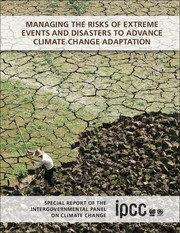 Managing the Risks of Extreme Events and Disasters to Advance Climate Change Adaptation
Managing the Risks of Extreme Events and Disasters to Advance Climate Change Adaptation from Section III
Published online by Cambridge University Press: 05 August 2012
Executive Summary
Increasing global interconnectivity, population, and economic growth, and the mutual interdependence of economic and ecological systems, can serve both to reduce vulnerability and to amplify disaster risks (high confidence). Global development pathways are becoming a more important factor in the management of vulnerability and disaster risk. [7.2.1]
The international community has accumulated substantial experience in providing help for disasters and risk management in the context of localized and short-term events associated with climate variability and extremes. Experience in disaster risk management includes both bottom-up and top-down approaches, but most often has developed from disasters considered first as local issues, then at the national level, and only at the international level where needs exceed national capacity, especially in terms of humanitarian assistance and capacity building. [7.2.4]
There are two main mechanisms at the international level that are purpose-built and dedicated to disaster risk management and climate change adaptation. These are the United Nations International Strategy for Disaster Reduction (UNISDR) and the United Nations Framework Convention on Climate Change (UNFCCC), in particular in its adaptation components. This chapter focuses on these two bodies while recognizing that there are many others that have an international role to play. Page limitations require a selective approach and a comprehensive assessment of all relevant bodies is impractical. The UNISDR and the UNFCCC are very different institutions with different mandates and scope and objectives, and with varying strengths and capacities (high confidence).
To save this book to your Kindle, first ensure no-reply@cambridge.org is added to your Approved Personal Document E-mail List under your Personal Document Settings on the Manage Your Content and Devices page of your Amazon account. Then enter the ‘name’ part of your Kindle email address below. Find out more about saving to your Kindle.
Note you can select to save to either the @free.kindle.com or @kindle.com variations. ‘@free.kindle.com’ emails are free but can only be saved to your device when it is connected to wi-fi. ‘@kindle.com’ emails can be delivered even when you are not connected to wi-fi, but note that service fees apply.
Find out more about the Kindle Personal Document Service.
To save content items to your account, please confirm that you agree to abide by our usage policies. If this is the first time you use this feature, you will be asked to authorise Cambridge Core to connect with your account. Find out more about saving content to Dropbox.
To save content items to your account, please confirm that you agree to abide by our usage policies. If this is the first time you use this feature, you will be asked to authorise Cambridge Core to connect with your account. Find out more about saving content to Google Drive.